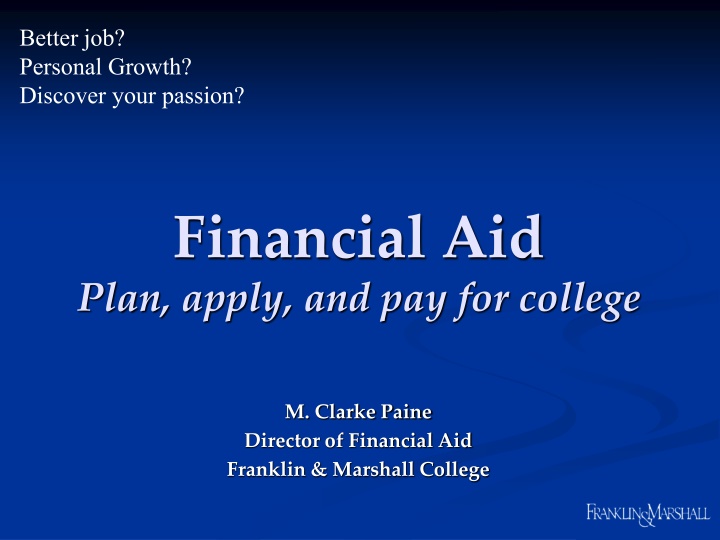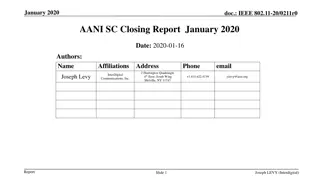
Maximize Financial Aid for College: Tips and Tools to Secure Affordable Education
Learn how to navigate the financial aid process effectively to make college education more affordable. Discover essential tips, tools, and resources to maximize your chances of receiving financial aid. From understanding the role of the financial aid office to utilizing the Net Price Calculator, this guide will help you plan and apply for financial aid with confidence.
Download Presentation

Please find below an Image/Link to download the presentation.
The content on the website is provided AS IS for your information and personal use only. It may not be sold, licensed, or shared on other websites without obtaining consent from the author. If you encounter any issues during the download, it is possible that the publisher has removed the file from their server.
You are allowed to download the files provided on this website for personal or commercial use, subject to the condition that they are used lawfully. All files are the property of their respective owners.
The content on the website is provided AS IS for your information and personal use only. It may not be sold, licensed, or shared on other websites without obtaining consent from the author.
E N D
Presentation Transcript
Better job? Personal Growth? Discover your passion? Financial Aid Plan, apply, and pay for college M. Clarke Paine Director of Financial Aid Franklin & Marshall College
What Will Be Presented What to Do Now Role of the Financial Aid Office How to Apply for Financial Aid Types of Financial Aid Your Questions
Discuss College Finances Now Family The Hun School Professional Staff College Admission Office Financial Aid Office Others
Net Price Calculator (NPC) (Web-based Tool to Use Now!) When cost is a factor, use the Net Price Calculator Each school is required to have one many use a similar tool, so you may only have to enter data one time This will help you in determining the net price of the school. Don t let sticker price scare you. You may be eligible for more financial aid than you think and what you need to be concerned about is what the net price will cost. Be very careful when inputting the data the output data your receive will only be as accurate as your input. If you put wrong information in, it may give you misleading output. Read the questions very carefully.
Principals of Financial Aid Student and parent(s) have primary responsibility for funding postsecondary education to the extent they are able. Families will be treated equitably and consistently by the need-analysis formula.
You Can be Considered . . . for these types of financial aid when you electronically file the FAFSA and and CSS/PROFILE Both applications available beginning October 1st of Senior Year Year October 1st of Senior
Purpose of Each Application FAFSA - Determines your eligibility for need-based aid from the Federal & some State Governments. CSS/PROFILE - Determines your eligibility for need-based aid for some colleges institutional funds.
For the FAFSA, start here . . . Make a correction Providing Signatures Continuing a Saved FAFSA Viewing your Student Aid Report (SAR), etc. New Mobile App!
How To Begin To Apply Students and parents will need to create an FSA ID which is comprised of a username and password. Your FSA ID can be used to: Electronically sign Federal Student Aid documents, Access your personal records, and Make binding legal obligations. If you are a parent and need to electronically sign your child s FAFSA, you need your own FSA ID. If you have more than one child attending college, you can use the same FSA ID to sign their applications. If you do not already have an FSA ID and would like to apply for one, select the Create an FSA ID tab on the FSA ID log-in page. For more information, see Federal Student Aid Online at: https://fsaid.ed.gov/npas/pub/faq.htm
Be Prepared to Submit 2019 Federal Tax Documents Federal Tax Documents Tax Return (1040, 1040A, 1040EZ) Tax Schedules Business Tax Returns W-2s Parent and Student Supplemental documents
How Is My Financial Aid Determined? Colleges determine your financial aid based on the following equation. Also known as Need Analysis. Cost of Attendance (COA) Expected Family Contribution (EFC) Financial NEED(Financial Aid Eligibility)
What is the Expected Family Contribution (EFC)? A figure derived from the information that you/your parents submitted on the FAFSA and CSS/PROFILE. The EFC is used to determine the types and amounts of need- based aid you may receive.
What is the Cost of Attendance COA)? Also known as the Student Budget, includes most everything related to college expenses for one academic year which is nine (9) months. Tuition and fees Room and meal plan Books and supplies Transportation Miscellaneous educational expenses
Sources of Aid Federal State Institutional Private
Types of Financial Aid Gift Aid Free Money Student Loans Must Be Repaid Student Employment Spending Money
Federal Financial Aid Programs Pell Grant SEOG Federal EFC of 5500 or lower Maximum = $6,345/year Priority to Pell Grant recipients Maximum = $4,000/year Federal Work Study (FWS) Job on campus or in community Minimum wage or higher
Federal Direct Student Loan Program Subsidized Loans Current Rate 2.75% Must have financial need to qualify No interest accrues until while student is enrolled in school Unsubsidized Loans Current Rate 2.75% Not based on financial need Variable-Fixed Interest Rate rate changes July 1 each year, but whatever the rate is at the time the loan is disbursed, it will be fixed for the life of the loan. Loan fees of 1.057% are assessed at disbursement. Interest rates are based on 10-year Treasury Bill plus a percentage add- ons. To view chart of historical interest rates: http://www.direct.ed.gov/calc.html
Federal Direct Loan Limits Base Limit Subsidized or Unsubsidized Loan Extra Total Additional Unsubsidized Loan Total Potential Academic Year Limit Unsubsidized Federal Stafford Loan2 Guaranteed and Awarded Amount for Academic Year Year in College 1st year $4,0001 $3,500 $2,000 $5,500 $9,500 2nd year $4,0001 $4,500 $2,000 $6,500 $10,500 3rd year $5,0001 $5,500 $2,000 $7,500 $12,500 4th year $5,0001 $5,500 $2,000 $7,500 $12,500 1. Must be a Dependent Student whose Parents were denied the PLUS Loan 2. Student may need to request the additional amount by contacting the Office of Financial Aid
Federal Direct Student Loan Program REPAYMENT Begins 6 months after the student leaves school (graduates, withdraws, leave of absence) Lender is the U.S. Department of Education
Institutional Aid May be grants, scholarships, loans, employment May require institutional application and/or other supplemental financial aid forms Deadline dates are very important Each institution varies in resources available for awards, percentage of need met, & what formula they use Contact the Admissions or Financial Aid Office at each institution being considered
Professional Judgment Reduction in income Extraordinary medical or dental expenses Unreimbursed child care expenses Disability expenses Tuition for elementary or secondary school Documentation/Forms will likely be required. Contact the Financial Aid Office(s) of the school(s) for more information. *** 2020 OR 2021 income compared to 2019 income on FAFSA
Alternatives for Meeting Need Institutional or private 10 month payment plans Federal PLUS loan Loan in parent s name (biological, adoptive, or step-parent) Based on credit Lender is the U.S. Department of Education Payments for principle can be deferred each year for up to 4 years (provided the student is enrolled at least half-time) Current rate: 5.30% Loan fees of 4.236% are assessed at disbursement To see a chart of historical interest rates: http://www.direct.ed.gov/calc.html Alternative loans Loan in student s name, but usually requires a credible co-signer Money from private banks Variable interest rates and terms Check with aid office for a listing Payments for principle are deferred generally until 6 months after student graduates or drops below half-time status (continue to pay interest on loan)
What Can You Do Now if You are Not a Senior? FAFSA4caster.ed.gov This allows you to find out your eligibility for federal student aid by estimating your eligibility early in order to help you get better insight when making college choices. This is not just for high school juniors. Parents can use this tool to receive early estimates, create scenarios based on future earnings, and then establish college savings strategies. When finished you can see your estimated federal student aid eligibility information based on the answers provided in FAFSA4caster. LOOK FOR SCHOLARSHIPS!!! Apply for any you can now pay attention to deadlines! Be prepared for those you can apply for when it is time (generally your senior year of high school is the earliest you can apply for most).
Higher Education Tax Benefits Education Credits American Opportunity Credit Student loan interest deductibility Tuition and Fees Deduction Coverdell Education Savings Accounts (ESA), previously referred to as Education IRAs http://www.batescarter.com/fullpanel/uploads/files/istock-000003403356xsmall.jpg 529 Plans
Online Financial Aid Resources finaid .org
Informational Sources How accurate is the data & How do I interpret the data? College Board Big Futures Campus Explorer The Princeton Review College View Cappex College Navigator
Financial Aid Tips Students: Be involvedin the financial aid process this is your education! Every student should file a FAFSA for his/her first year. Meet all deadlines and respond promptly to requests for additional information. Stay organized Take the time to explore and apply for outside scholarships and other funding sources.
Financial Aid Tips (cont.) Contact the financial aid office with any unusual financial circumstances. Don t forget that you will need to complete new financial aid applications for each academic year. HINT: Every year you file taxes, file your FAFSA) Make certain you know how you are going to pay for your out-of- pocket expenses (books, supplies, personal expenses). Above all ASK QUESTIONS!!! This process can seem confusing and overwhelming. Anytime you are uncertain about anything ASK!!!
M. Clarke Paine Franklin & Marshall College Office of Financial Aid 717.358.3991 www.fandm.edu/financialaid Clarke.paine@fandm.edu











